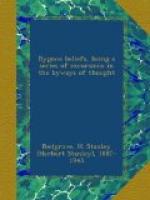Another legend accounts for the robin’s red breast by supposing this bird to have tried to pluck a thorn from the crown encircling the brow of the crucified CHRIST, in order to alleviate His sufferings. No doubt it is on account of these legends that it is considered a crime, which will be punished with great misfortune, to kill a robin. In some places the same prohibition extends to the wren, which is popularly believed to be the wife of the robin. In other parts, however, the wren is (or at least was) cruelly hunted on certain days. In the Isle of Man the wren-hunt took place on Christmas Eve and St Stephen’s Day, and is accounted for by a legend concerning an evil fairy who lured many men to destruction, but had to assume the form of a wren to escape punishment at the hands of an ingenious knight-errant.
For several centuries there was prevalent over the whole of civilised Europe a most extraordinary superstition concerning the small Arctic bird resembling, but not so large as, the common wild goose, known as the barnacle or bernicle goose. MAX MUELLER[1] has suggested that this word was really derived from Hibernicula, the name thus referring to Ireland, where the birds were caught; but common opinion associated the barnacle goose with the shell-fish known as the barnacle (which is found on timber exposed to the sea), supposing that the former was generated out of the latter. Thus in one old medical writer we find: “There are founde in the north parts of Scotland, and the Ilands adjacent, called Orchades [Orkney Islands], certain trees, whereon doe growe certaine shell fishes, of a white colour tending to russet; wherein are conteined little liuing creatures: which shells in time of maturitie doe open, and out of them grow those little living things; which falling into the water, doe become foules, whom we call Barnakles . . . but the other that do fall vpon the land, perish and come to nothing: this much by the writings of others, and also from the mouths of the people of those parts...."[1b]
[1] See F. MAX MUELLER’S Lectures on the Science of Language (1885), where a very full account of the tradition concerning the origin of the barnacle goose will be found.
[1b] JOHN GERARDE: The Herball; or, Generall Historie of Plantes (1597). 1391.
The writer, however, who was a well-known surgeon and botanist of his day, adds that he had personally examined certain shell-fish from Lancashire, and on opening the shells had observed within birds in various stages of development. No doubt he was deceived by some purely superficial resemblances—for example, the feet of the barnacle fish resemble somewhat the feathers of a bird. He gives an imaginative illustration of the barnacle fowl escaping from its shell, which is reproduced in fig. 12.
Turning now from superstitions concerning actual birds to legends of those that are purely mythical, passing reference must be made to the roc, a bird existing in Arabian legend, which we meet in the Arabian Nights, and which is chiefly remarkable for its size and strength.




